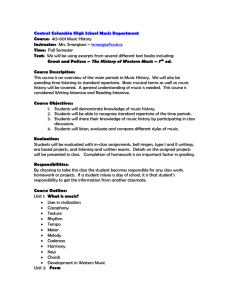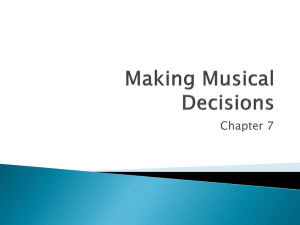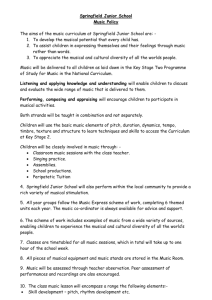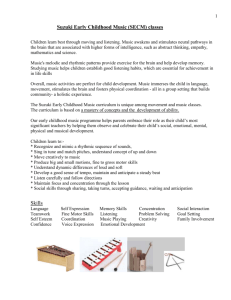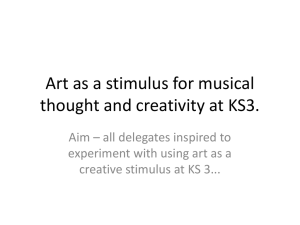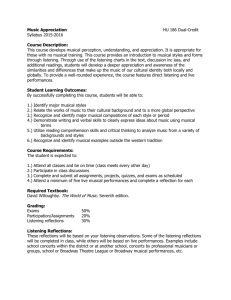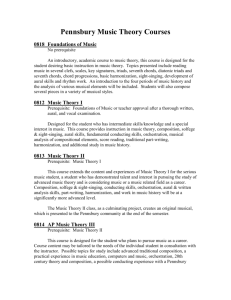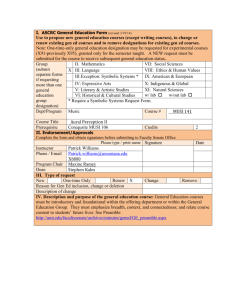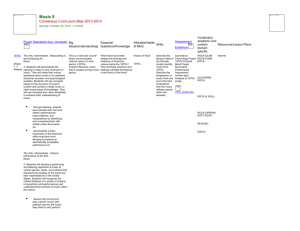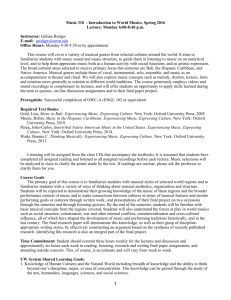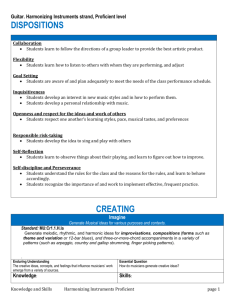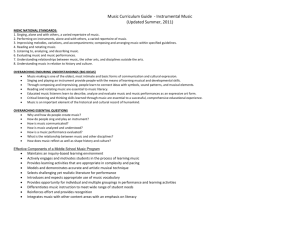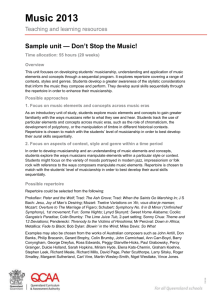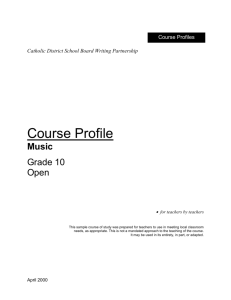HS AP Music Theory - Upper Moreland School District
advertisement
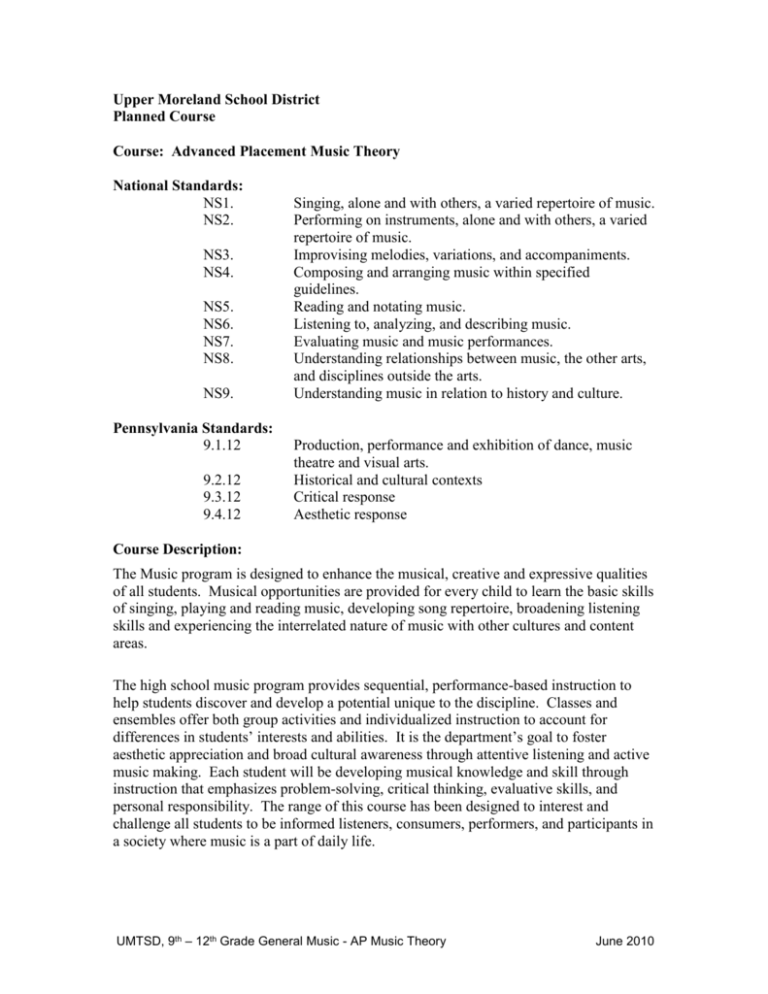
Upper Moreland School District Planned Course Course: Advanced Placement Music Theory National Standards: NS1. NS2. NS3. NS4. NS5. NS6. NS7. NS8. NS9. Pennsylvania Standards: 9.1.12 9.2.12 9.3.12 9.4.12 Singing, alone and with others, a varied repertoire of music. Performing on instruments, alone and with others, a varied repertoire of music. Improvising melodies, variations, and accompaniments. Composing and arranging music within specified guidelines. Reading and notating music. Listening to, analyzing, and describing music. Evaluating music and music performances. Understanding relationships between music, the other arts, and disciplines outside the arts. Understanding music in relation to history and culture. Production, performance and exhibition of dance, music theatre and visual arts. Historical and cultural contexts Critical response Aesthetic response Course Description: The Music program is designed to enhance the musical, creative and expressive qualities of all students. Musical opportunities are provided for every child to learn the basic skills of singing, playing and reading music, developing song repertoire, broadening listening skills and experiencing the interrelated nature of music with other cultures and content areas. The high school music program provides sequential, performance-based instruction to help students discover and develop a potential unique to the discipline. Classes and ensembles offer both group activities and individualized instruction to account for differences in students’ interests and abilities. It is the department’s goal to foster aesthetic appreciation and broad cultural awareness through attentive listening and active music making. Each student will be developing musical knowledge and skill through instruction that emphasizes problem-solving, critical thinking, evaluative skills, and personal responsibility. The range of this course has been designed to interest and challenge all students to be informed listeners, consumers, performers, and participants in a society where music is a part of daily life. UMTSD, 9th – 12th Grade General Music - AP Music Theory June 2010 The goals of Advanced Placement Music Theory include: Mastering terminology and the musical notation system. Using aural and notational skills to master rudiments: intervals, rhythm and meter, scales and modes, chord structure, chord function, cadences, embellishments, and form. Completion of complex and creative tasks: creating an appropriate bass line for a melody, realizing a figured bass line, realizing a progression in Roman Numerals, and analysis of repertoire. Experience in using four-voice texture (common practice), and counterpoint. A study of motivic treatment and musical form through score study and composition. Advanced Placement Music Theory is a challenging, rigorous course that will cover the properties of Western Music and its development over time. The course will cover the theoretical knowledge of music notation, and advanced aural skills. Students will need to complete homework outside of class that will include listening to CDs, written exercises, and composition in preparation for the National College Board AP test. College credit depends upon the AP test score and the college of choice. The AP Music Theory test is strongly recommended. Prerequisites: Successful completion of Music Theory I course, recommendation by a High School Music teacher or a placement test. Specific and measurable objectives directly related to the academic standards to be achieved by students: This course is an advanced class intended to follow the national AP curriculum and culminate in students taking the AP College Board test. It also prepares students for college courses, whether they choose to take music as a major or minor, or remain in performing ensembles. Content to be used to reach objectives: In order for students to listen to, perform, and analyze music, a variety of instructional activities and materials will be utilized. UMTSD, 9th – 12th Grade General Music - AP Music Theory June 2010 Materials: Theory text: Clendinning, Jane Piper and Marvin, Elizabeth West. The Musician’s Guide to Theory and Analysis. New York: W.W. Norton & Co. Inc. 2005. Scores for study: The Norton Scores; An Anthology for Listening. 4th edition standard. Ed. Roger Kamien. New York: W.W. Norton & Co. 1984. Burkhart, Charles. Anthology for Musical Analysis. 4th edition. New York: Holt, Reinhart and Winston Inc. 1986. Bockmon, Guy Alan and Starr, William J. Scored for Listening: A Guide to Music. 2nd edition. Harcourt Brace Jovanovich, Inc. 1972. Sight-singing materials: Snyder, Audrey. The Sight-Singer Volume I; A Practical Sight-Singing Course for Two-Part Mixed, or Three-Part Mixed Voices. Miami, Florida: Belwin Inc. 1993. Teacher created materials Technology resources (Interactive Whiteboard, web-based resources, and CD/DVD player and related audio equipment) Finale Music notation software Synthesizers Instructional Activities: Musical skills are developed by the following types of exercises: Listening Sight-singing Rhythmic, melodic and harmonic dictation Written exercises using music notation Analysis of repertoire Composition Direct Instruction Class Discussion Estimated instructional time to be devoted to achieving objectives: 5 days per week, 45 minute periods, 36 weeks In addition, outside of class independent work is required to achieve all objectives. Procedure for measurement of student progress on the objective: A variety of assessments will be used. Listening exams Sight-singing performance rubrics Dictation exams Written exams Composition rubrics Homework/classwork checks Contribution to class discussion UMTSD, 9th – 12th Grade General Music - AP Music Theory June 2010 An explanation of how student grades will be determined: A student’s grade will be determined through a minimum of 5 assessments per marking period. The assessments will vary in weight and will be used collectively to calculate each marking period grade. UMTSD, 9th – 12th Grade General Music - AP Music Theory June 2010
